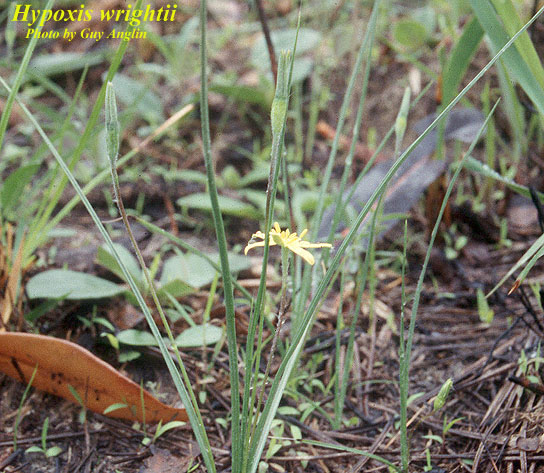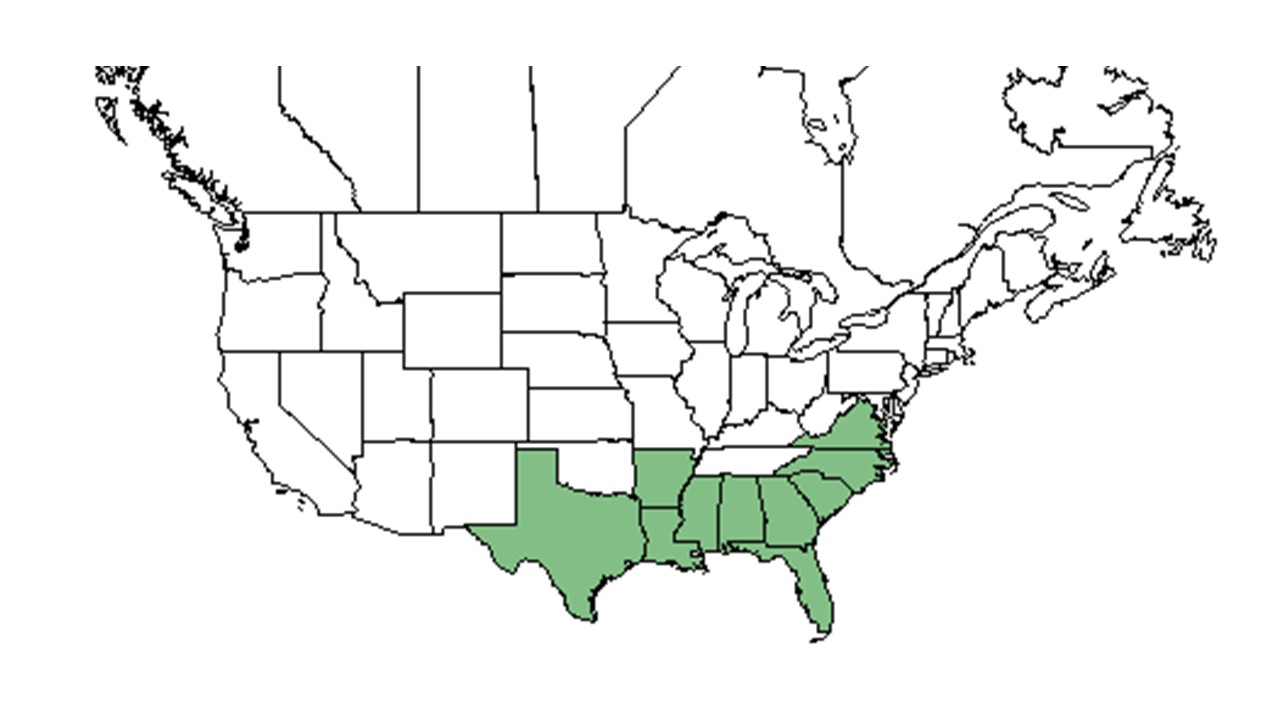Hypoxis wrightii
| Hypoxis wrightii | |
|---|---|

| |
| Photo by Guy Anglin, Atlas of Florida Vascular Plants | |
| Scientific classification | |
| Kingdom: | Plantae |
| Division: | Magnoliophyta - Flowering plants |
| Class: | Liliopsida - Monocotyledons |
| Order: | Liliales |
| Family: | Liliaceae |
| Genus: | Hypoxis |
| Species: | H. wrightii |
| Binomial name | |
| Hypoxis wrightii (Baker) Brackett | |

| |
| Natural range of Hypoxis wrightii from USDA NRCS Plants Database. | |
Common names: Wright's star-grass, Bristleseed yellow stargrass[1]
Contents
Taxonomic notes
Synonyms: Hypoxis micrantha Pollard.[1]
Varieties: none.[1]
Description
A description of Hypoxis wrightii is provided in The Flora of North America. H. wrightii is a perennial, geocarpic herb with a cryptic life cycle. The stem is buried 2 to 3 centimeters below the soil surface with grass-like leaves arranged in a rosette above.[2]
Distribution
This species occurs from southeast Virginia to southern Florida, and west to Texas. It also occurs in the West Indies.[1]
Ecology
Habitat
Habitats include wet pine savannas, seasonally flooded prairies, moist roadsides, and in Florida it has been found in limestone glades.[3][4][2] It can mostly be found in frequently-burned communities due to the strong flowering response after fires. [2] Grows in loamy calcareous sand and sandy loam. Associated species include Schoenus, Juniperus, and Sideroxylon.[4]
Phenology
H. wrightii is geocarpic with a cryptic life cycle. It produces both chasmogamous and cleistogamous flowers. Individuals bud and fruit throughout the entire year, however, reproductive activity is the highest during the rainy summer months and the lowest during the dry winter months.[2] Herbarium specimen have documented this species flowering in May.[4] Kevin Robertson has observed this species flower within three months of burning. KMR It has been observed flowering from February to July and in September with peak inflorescence in April. [5]
Seed dispersal
The seeds are small and hard to differentiate without a microscope from other Hypoxis species. They are dull dark brown, with wrinkled, detached cuticles.[6] Tepals persist on the seed through maturity.[2] This species is thought to be dispersed by wind.[7]
Seed bank and germination
Quickly growing and reproducing after fire allows H. wrightii to disperse seeds into an ideal habitat for germination and establishment.[2]
Fire ecology
H. wrightii grows frequently in burned communities and has a strong reproductive response to burning. It is favorable to grow and reproduce quickly after a fire, allowing for ideal seedling establishment and germination. Fire stimulates H. wrightii to produce a two-flowered inflorescence. Inflorescences that are produced immediately after fire tend to be longer than those produced three or more months post-fire. Three months post-fire has been observed to be the highest reproductive period. Tepal length has also been recorded to be longer in flowers produced soon after a fire compared to flowers produced later. The early chasmogamous flowers produce fewer seeds following a fire compared to later cleistogamous flowers. The transition from chasmogamous to cleistogamous flowers occurred rapidly, with chasmogamous flowers being produced for a maximum of four weeks. It is speculated that reproduction rates are high following fire due to increased light levels by removing the litter layer, soil fertility, and the increase in the availability of soil water and nutrient reserves.[2]
Herbivory and toxicology
It has been observed that in the first year post-fire there was a high rate of leaf destruction by grazing vertebrates, mainly the cottontail rabbit and whitetail deer.[2]
Conservation, cultivation, and restoration
Cultural use
Photo Gallery
References and notes
- ↑ 1.0 1.1 1.2 1.3 Weakley, A.S. 2015. Flora of the southern and mid-atlantic states. Working Draft of 21 May 2015. University of North Carolina at Chapel Hill, Chapel Hill, North Carolina.
- ↑ 2.0 2.1 2.2 2.3 2.4 2.5 2.6 2.7 Herndon, A. (1988). "Ecology and Systematics of Hypoxis sessilis and H. wrightii (Hypoxidaceae) in Southern Florida." American Journal of Botany 75(12): 1803-1812.
- ↑ [[1]] Accessed: January 6, 2016
- ↑ 4.0 4.1 4.2 Florida State University Robert K. Godfrey Herbarium database. URL: http://herbarium.bio.fsu.edu. Last accessed: October 2015. Collectors: Loran C. Anderson, Wilson Baker, Ann Johnson, L.B. Trott. States and Counties: Florida: Gadsden, Jackson, Wakulla. Compiled by Tall Timbers Research Station and Land Conservancy.
- ↑ Nelson, G. PanFlora: Plant data for the eastern United States with emphasis on the Southeastern Coastal Plains, Florida, and the Florida Panhandle. www.gilnelson.com/PanFlora/ Accessed: 12 DEC 2016
- ↑ Zona, S., J. Prince, et al. (2009). "A Seed Atlas of Hypoxis from Eastern North America." Journal of the Torrey Botanical Society 136(1): 26-32.
- ↑ Kirkman, L. Katherine. Unpublished database of seed dispersal mode of plants found in Coastal Plain longleaf pine-grasslands of the Jones Ecological Research Center, Georgia.